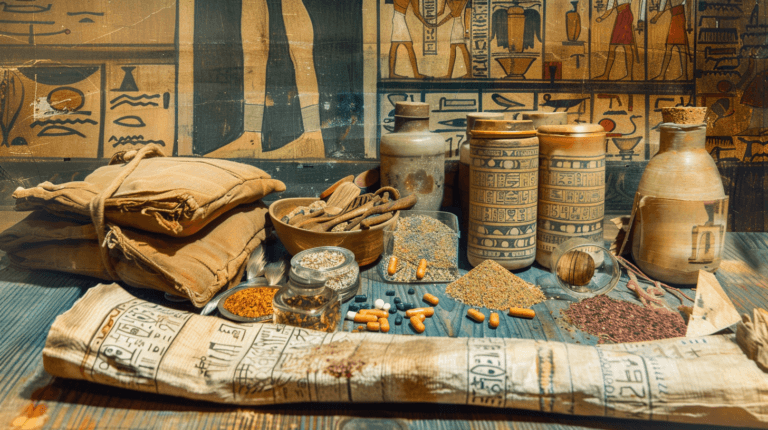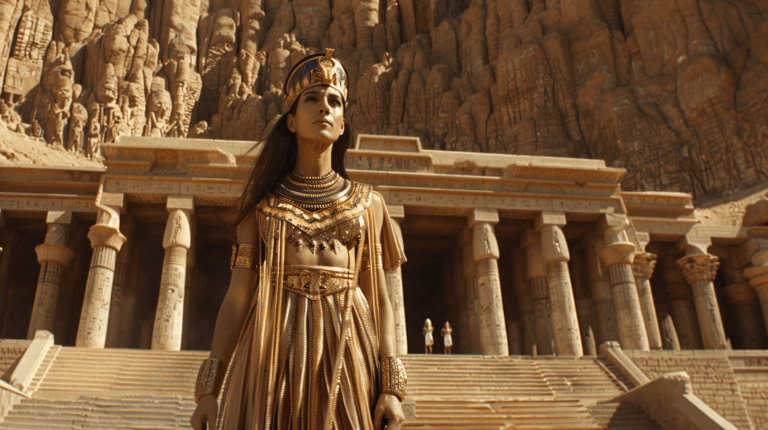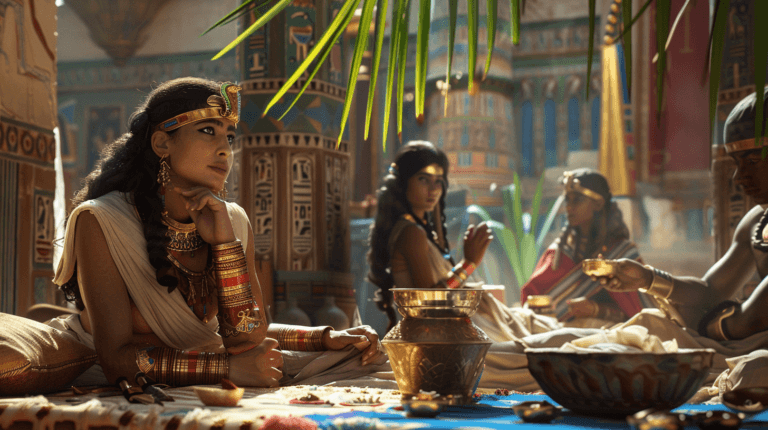Who Was the First Pharaoh Narmer?
The First Pharaoh Narmer is a fascinating figure from Ancient Egypt. He is credited as the first king who unified Egypt, marking the beginning of the First Dynastic Period around 3150 BCE. According to various sources, Narmer is also considered by some historians to be the same person as Menes, the legendary king known for his conquest of Lower Egypt.
Narmer’s story is pieced together from numerous artifacts and inscriptions. One of the most famous pieces of evidence is the Narmer Palette, which depicts his victory and unification of Egypt. It’s amazing to think about how this one person could have had such a significant impact on an entire civilization.
Narmer’s reign laid down the foundations for what would become one of the most remarkable civilizations in history. This peaceful unification under Narmer allowed Egypt to flourish culturally and economically. The mysteries surrounding his life and reign continue to intrigue historians and enthusiasts alike.
First Pharaoh Narmer Historical Context
Narmer played a crucial role in Egypt’s history, marking the transition from the Predynastic Period to the Early Dynastic Period. His reign symbolized the unification of Upper and Lower Egypt.
Predynastic Period
The Predynastic Period of Egypt began around 6000 BCE and lasted until approximately 3150 BCE.
This era saw the gradual development of small, separate tribes along the Nile River. Each tribe had its own customs and leaders.
During this time, Egypt wasn’t a single nation. Instead, there were many small, independent communities. They practiced agriculture, built settlements, and developed pottery.
Artifacts from this period show increasing complexity and skill, indicating social and cultural advancements.
Towards the end of this period, larger chiefdoms began to emerge. These chiefdoms started to consolidate power and influence over nearby smaller communities. Trade routes expanded, leading to greater resource exchange. The groundwork for unification began as these chiefdoms grew more powerful and began interacting with one another.
Early Dynastic Period

“Narmer’s reign was a turning point in Egyptian history, marking the dawn of a new era of centralized rule under the pharaohs.” – Egyptologist
The Early Dynastic Period started around 3150 BCE, marked by Narmer’s reign. This period is known for the establishment of a centralized government and the formation of Egypt’s First Dynasty. Narmer is often credited with the unification of Upper and Lower Egypt.
Narmer’s reign set many foundations for Ancient Egyptian civilization. He introduced administrative organization and the concept of a divine kingship.
Important artifacts from his time, like the Palette of King Narmer, depict his achievements and military prowess.
This period also saw the construction of early monumental architecture and the development of writing, specifically hieroglyphics.
The capital moved to Memphis, which became a cultural and political hub.
Egypt’s centralized state allowed for more coordinated and expansive building projects, laying the groundwork for the future great pyramids.
Life and Reign of Narmer
Narmer is widely recognized for his crucial role in unifying Egypt. His name is often linked with Pharaoh Menes, and he introduced several important changes that shaped early Egyptian civilization.
Name and Identity
Narmer’s name means “striking catfish,” reflecting symbols found on a ceremonial palette known as the Narmer Palette. This tablet is decorated with scenes showing Narmer in powerful poses.
Many historians identify Narmer as the first pharaoh of the 1st Dynasty and possibly the last ruler of the Predynastic Period. There’s also a common belief that Narmer and Menes could be the same person, combining peaceful and military methods to unite Egypt.
Reign and Achievements
During Narmer’s reign, he is credited with unifying Upper and Lower Egypt. This unification marked the beginning of the First Dynastic Period around 3100 BCE.
One of his most significant artifacts is the Narmer Palette, which highlights his victory over Lower Egypt.
Narmer also founded the capital city of Memphis, which became a pivotal center for administration and culture in ancient Egypt.
His reign laid the groundwork for successive pharaohs, ensuring a long and stable dynastic rule. His contributions have been recorded in various inscriptions and artifacts, offering valuable insights into his leadership.
Narmer’s Unification of Egypt

Narmer played a crucial role in merging Upper and Lower Egypt into a single kingdom, leading to the formation of the 1st Dynasty. His efforts established the political and cultural foundation for ancient Egypt.
Conquest of Lower Egypt
Narmer is believed to have united Egypt through a combination of political skills and military conquests. Before his reign, Egypt was divided into two regions: Upper Egypt to the south and Lower Egypt to the north. Narmer, hailing from Upper Egypt, embarked on a campaign to bring Lower Egypt under his control.
The Narmer Palette, an ancient ceremonial tablet, depicts some of his triumphs. One side shows Narmer wearing the White Crown of Upper Egypt. The opposite side shows him in the Red Crown of Lower Egypt. This symbolism indicates that he ruled over a united Egypt. Some scholars believe he achieved this unity peacefully. Others think he used force to consolidate power.
“The Narmer Palette provides a visual narrative of Narmer’s conquest and unification, showcasing the subjugation of different regions and the establishment of a centralized power.” – Dr. Amelia Johnson, Egyptologist
Political Significance
Narmer’s unification of Egypt wasn’t just a military achievement; it had deep political implications too.
By joining Upper and Lower Egypt, he laid the groundwork for a centralized government. This unity allowed for national projects like the construction of temples and the development of a shared culture.
Establishing the 1st Dynasty marked a new era in Egyptian history. Narmer set up his capital at Memphis, strategically located between Upper and Lower Egypt. This further cemented the unification.
His reign also saw the development of administrative systems that would define Egyptian rule for centuries.
By creating a centralized monarchy, Narmer not only unified Egypt but also set a precedent for future pharaohs. This political stability helped Egypt flourish, paving the way for it to become one of the most influential civilizations in history.
Cultural and Historical Impact
Pharaoh Narmer played a key role in shaping ancient Egyptian civilization through art, symbolisms, and establishing monarchy. His reign marked significant cultural developments.
Narmer Palette and Iconography
The Narmer Palette is an iconic piece of art from Narmer’s time. It depicts Narmer wearing the crown of both Upper and Lower Egypt, suggesting he unified the two regions.
This piece of art is one of the earliest examples of intricate Egyptian iconography, showing symbols like the falcon god Horus and intertwined beasts. It reveals how early Egyptians used art to demonstrate power and divine approval. The palette shows Narmer defeating his enemies, highlighting his strength and leadership.
Monarchy and Symbolism

Narmer’s reign marked the beginning of the First Dynastic Period in Egypt, establishing him as a powerful monarch.
He is often credited with founding the first centralized monarchy in ancient Egypt, blending political and spiritual leadership.
The symbolism associated with Narmer’s rule is rich.
For example, the Narmer Palette shows symbols like the double crown, representing the unification of Upper and Lower Egypt. These symbols became essential in Egyptian monarchy, continuing to influence royal iconography for centuries.
Narmer’s establishment of centralized rule set a precedent for future pharaohs, blending governance and religious leadership seamlessly.
Narmer’s Tomb and Burial
Narmer’s burial remains a mystery, filled with intriguing details that captivate historians. Both the artifacts found and the excavations conducted at his tomb provide valuable insights into ancient Egyptian practices.
Grave Goods

When archaeologists discovered Narmer’s tomb, they found an array of grave goods. These items included pottery, jewelry, and tools. Each object found suggests what was important to Narmer in life and what he might need in the afterlife.
For instance, arrowheads were found, showing that Narmer might have been a hunter or a warrior. The pottery pieces provide a glimpse into the everyday life and art of his time.
These goods are not only valuable artifacts but also serve as a window into the past, illuminating the culture and beliefs of ancient Egypt.
Umm el-Qaab Excavations
The tomb of Narmer is located in the Umm el-Qaab burial ground near Abydos. This site has been the subject of extensive excavations.
Narmer’s tomb consists of two large pits, B17 and B18, which were found in the 1890s. The larger pit, B17, measures about 3 by 4.1 meters, while B18 is slightly smaller.
These pits were part of early explorations and have been pivotal in understanding ancient royal burials. Though the exact burial site remains a bit of a mystery, the tomb’s structure and findings paint a vivid picture of Narmer’s burial practices. The site continues to be a significant archaeological interest, drawing many to study the reign of Egypt’s first pharaoh.
Narmer in Historical Records
Narmer, often linked with unifying Egypt, appears in several important historical records. These records include king lists, royal decrees, and various archaeological artifacts that help us understand his reign and significance.
King Lists
In ancient Egypt, king lists were crucial for documenting the reigns of pharaohs.
Narmer shows up on some of these lists. The Turin King List and the Palermo Stone are key records that mention him.
The Palermo Stone details various important events and rituals during the early dynasties. Narmer is often linked with the pharaoh Menes, who is said to have unified Upper and Lower Egypt.
Egyptian historian Manetho also mentions Narmer. He described Narmer as the first ruler who brought together the two lands of Egypt.
This information helps us piece together Narmer’s role in early Egyptian history, showing how he laid the foundation for the future pharaohs.
Royal Decrees
Royal decrees from Narmer’s time offer a window into how he ruled and maintained power.
These decrees were often inscribed on stone, clay, and other materials, making them valuable for historians.
The Narmer Palette is a key artifact that depicts Narmer in a ceremonial act. It is believed to commemorate his unification of Egypt and provides insight into his reign.
Another important piece is the Year Label, which records significant events during the year of a pharaoh’s reign.
These labels are crucial for understanding how Narmer structured his rule. They mention military campaigns, religious rituals, and economic activities, giving us a detailed picture of his administration.
Debating Narmer’s Legacy
Debates about Narmer’s legacy often center on his identity and historical impact, challenging the clarity of his achievements and his place in history.
Narmer Versus Menes
Narmer is often confused with Menes. Some historians believe Narmer and Menes might actually be the same person.
It’s an interesting debate because Menes is credited with unifying Egypt through conquest. Narmer, on the other hand, is thought to have achieved this unification peacefully. This debate affects how we view Egypt’s earliest leadership style.
Narmer’s unification efforts are depicted on the Narmer Palette, an ancient archaeological find. On the flip side, Menes is credited with founding Memphis, Egypt’s first capital.
Whether these achievements belong to one person or two remains a hot topic. Scholars continue to analyze artifacts and texts to pinpoint the true identity and contributions of these early leaders.
Historiographical Challenges
Studying Narmer’s legacy is tricky. Much of the historical evidence is fragmented or unclear. Ancient records are sparse, making it difficult to confirm specific events or achievements.
Scholars often rely on pieces like the Narmer Palette to construct narratives about his reign. This limited evidence base leads to different interpretations among historians.
The impact of Narmer’s reign is significant, yet hard to detail precisely. Some experts see him as a foundational figure. They believe his centralized government set the stage for Egypt’s grandeur.
Others argue the evidence is too patchy to credit him entirely. These historiographical challenges keep the debate about Narmer’s true legacy alive and complex.
Artefacts and Archaeology

I think one of the coolest things about studying Pharaoh Narmer is the artefacts we’ve discovered. Some of the most famous pieces include the Narmer Palette and the Narmer Macehead.
The Narmer Palette is a ceremonial stone tablet. Found in Hierakonopolis, it shows amazing carvings of Narmer wearing both Upper and Lower Egyptian crowns. This probably means he was the pharaoh who united Egypt.
Then there’s the Narmer Macehead. It’s less famous but still important. Also found at Hierakonpolis, it’s a decorated stone with scenes that might show Narmer’s rituals and events, offering a glimpse into the past.
Flinders Petrie, a well-known Egyptologist, did a lot of work on Narmer. Petrie’s excavations brought many seal impressions and other artefacts to light. His careful work helped piece together Narmer’s time and achievements.
Finds at Hierakonpolis weren’t just limited to the big items. Everyday stuff like pottery and tools were also found, helping us picture life back then. The seal impressions found show scenes and hieroglyphs that help identify various kings, including Narmer.
Learning about these artefacts makes history feel real. They tell stories of a time long ago, when Narmer ruled and Egypt began to unify. These artefacts are like pieces of a huge puzzle, each one adding to the picture.







